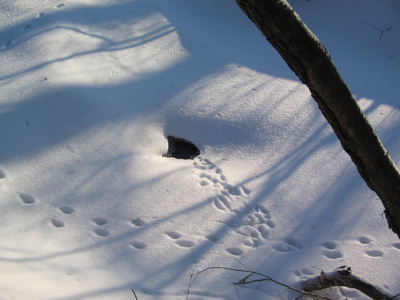![]() Observation: The First Step in the Scientific Method
Observation: The First Step in the Scientific Method
To observe means to look at something and to notice the details. When people observe things, they often wonder
why it is that way. Scientists strive to answer that question. They make observations. This is the first step of the scientific method.
Observations are also called data. There are two kinds of data.
- Qualitative data which are descriptions that do not have numbers.
It is cold with a brisk wind that makes your cheeks burn, is an example of qualitative data.
"Swallows certainly sleep all winter. A number of them conglobulate together, by flying round and round, and then all in a heap
throw themselves under water, and lye in the bed of a river." Dr. Samuel Johnson (1709-1784) b. Lichfield, England- Quantitative data are obtained by measuring and have numbers.
Scientists use instruments (tools) to obtain numbers based data.It is 4° Celsius with a Northeast wind at 20 miles per hour is an example of observations with quantitative data.
Practice observing by examining at this photo of a snow covered creek in Central Pennsylvania, USA.
Click here for a closer view. Use the Back Button of your browser to return to this web page.
1. Write your observations - one per line - on a piece of paper.
Make as many observations as you can.
2. Imagine - If you were standing in the scene:
What tools (instruments) would help you to be a better observer?
What tools (instruments) might you use to gather quantitative data about what you are observing?
Based on what you observe, what would you estimate to be the upper limit of the air temperature in the scene?
Explain how you arrive at that inference.
3. Write at least two hypothesis about what you have observed. What is a hypothesis?
"You have to be inquisitive about things. You have to have an open mind." Dr. Stephanie Kwolek
Extend your knowledge:
Watch the videos Quantifying Cold and The Ice Trade. | Explore the website Absolute Zero @ PBS.
About Units of Measurement - IB Biology | Observing Biology how to's | Animal Tracks
Temperature facts and figures - IB Biology | Observation - Science Skills Builders
Steps of the Scientific Method - Science Buddies | Learn about the Scientific Method Activity
Milkweed and Monarch Butterfly Mania Journal Entry | Bluebirds Project
Words from Illustrations and Art | Winter Song Digital Photo Story | Winter's Story - NASA
![]()
All trademarks, copyright and logos belong to their respective owners.
Internet Hunts / Nature / Water / Computers / Famous Pennsylvanians / Civics & History / Puzzles & Projects / Site map / Home
FAQ Posted
by Cynthia J. O'Hora 9/2007, released for noncommercial use by nonprofit organizations
Aligned
with Pennsylvania Academic Standards | Assessment and Rubrics
![]() Save a tree use a digital answer format - Highlight the text. Copy it. Paste it in a word processing document. Save the document in your folder. Answer on the word processing document. Save frequently as you work. I have never liked losing my work. You will not like it either. Be sure to enter your name & the date at the top of the document. Submit via email attachment or class dropbox. Bad things happen: Save a copy of the response document for your records.
Save a tree use a digital answer format - Highlight the text. Copy it. Paste it in a word processing document. Save the document in your folder. Answer on the word processing document. Save frequently as you work. I have never liked losing my work. You will not like it either. Be sure to enter your name & the date at the top of the document. Submit via email attachment or class dropbox. Bad things happen: Save a copy of the response document for your records.
Proof your responses. It is funny how speling errors and typeos sneak in to the bets work. ![]() Make your own printer paper answer sheet
Make your own printer paper answer sheet
Pennsylvania Academic Standards - The Nature of Science
Processes, Procedures and Tools of Scientific Investigations
• Apply knowledge of scientific investigation or technological design in different contexts to make inferences to solve problems.
• Use evidence, observations, or a variety of scales (e.g., time, mass, distance, volume, temperature) to describe relationships.
